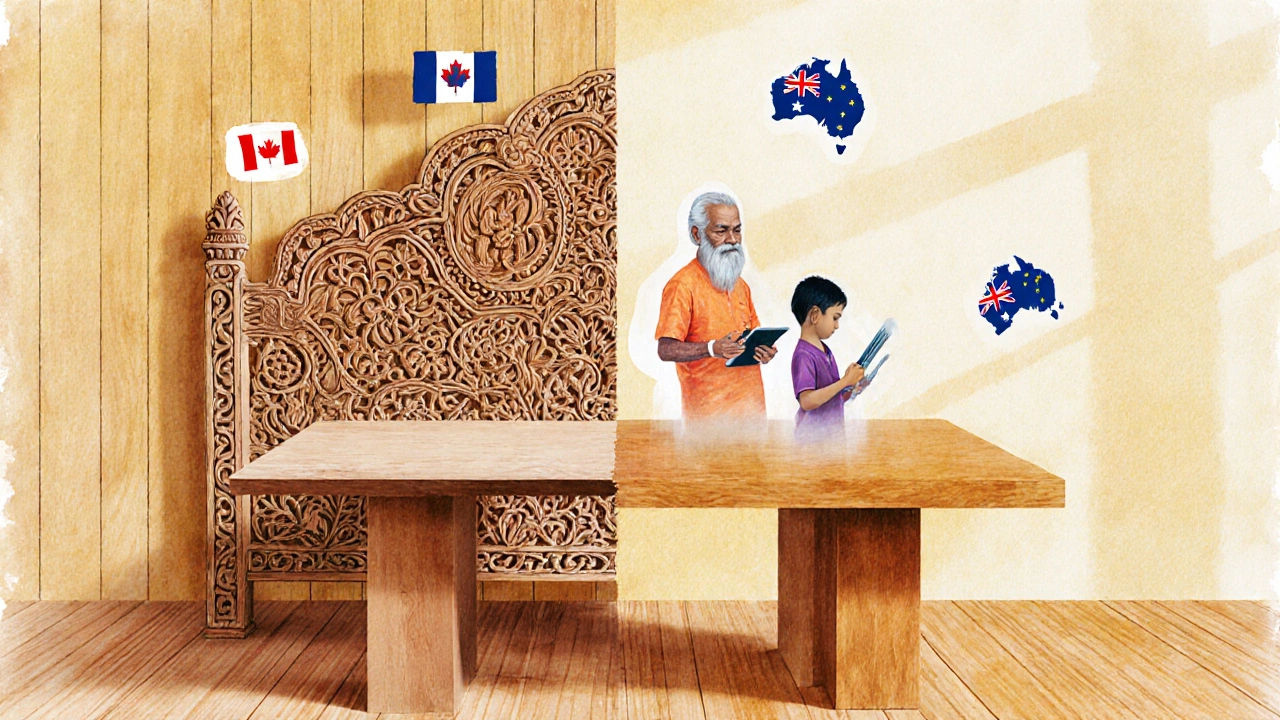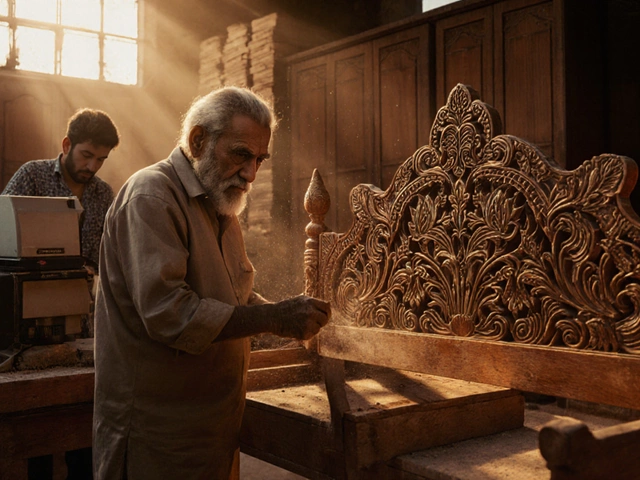Which Place in India Is Famous for Furniture? Top Manufacturing Hub Revealed

Furniture Cost Comparison Calculator
Select Your Furniture Type
Why Choose Khanna?
Khanna furniture uses solid wood like sheesham and teak, built to last 15-25 years with handcrafted quality. It's 40-60% more affordable than imported alternatives while maintaining superior craftsmanship.
Cost Comparison
If you’ve ever walked into a home with rich, hand-carved wooden furniture - the kind that feels like it’s been passed down for generations - there’s a good chance it came from one place in India: Khanna. This small town in Punjab isn’t on most tourist maps, but it’s the beating heart of India’s furniture industry. Over 80% of the country’s wooden furniture is made here, shipped across India and exported to over 60 countries. You won’t find luxury showrooms or glossy ads for Khanna, but you’ll find thousands of workshops, family-run factories, and truckloads of finished pieces heading out every day.
Why Khanna Became India’s Furniture Capital
Khanna’s rise wasn’t planned. It started in the 1960s when local carpenters began making simple wooden beds and cupboards for nearby villages. They used locally sourced sheesham and teak wood, which is dense, durable, and naturally resistant to termites. As demand grew, families started training their children in joinery, carving, and finishing. By the 1990s, Khanna had shifted from making single pieces to mass-producing entire bedroom and dining sets.
What set Khanna apart wasn’t just skill - it was cost. Labor here is cheaper than in cities like Delhi or Mumbai, but the quality doesn’t suffer. Workers still use hand tools for carving intricate floral patterns, while machines handle sanding and assembly. This mix of tradition and efficiency lets Khanna undercut imported furniture by 40-60% without losing craftsmanship.
Today, over 3,000 furniture units operate in and around Khanna. Many are family businesses that have been running for three or four generations. One workshop might specialize in bed frames, another in dining tables, and a third in carved wardrobes. They don’t need big brands - their reputation travels through word of mouth and wholesale distributors.
What Kind of Furniture Comes Out of Khanna?
Khanna doesn’t make just one style. It makes everything. You’ll find:
- Traditional Indian designs with detailed floral and geometric carvings
- Modern minimalist sets in sheesham or mango wood
- Upholstered sofas and recliners with wooden frames
- Outdoor furniture made from weather-resistant teak
- Custom-made pieces for hotels, offices, and luxury homes
Most pieces use solid wood, not particleboard or MDF. That’s why furniture from Khanna lasts 15-20 years - sometimes longer. A well-made sheesham dining table from Khanna can weigh over 80 kg and still look better after 10 years than a cheap imported one.
Exporters in Khanna follow international standards. They treat wood to meet IS 4000 (Indian Standard for timber seasoning) and use eco-friendly finishes approved by the EU and US. Many factories are ISO 9001 certified. That’s not common in small-town manufacturing, but Khanna’s reputation depends on it.
How Khanna Compares to Other Furniture Hubs in India
Other cities make furniture too - but none match Khanna’s scale or consistency.
| City | Primary Wood Used | Specialization | Export Volume | Production Capacity |
|---|---|---|---|---|
| Khanna (Punjab) | Sheesham, Teak, Mango | Hand-carved wooden furniture | High (60% of national exports) | 10,000+ units/month |
| Moradabad (Uttar Pradesh) | Sheesham, Pine | Decorative items, small tables | Moderate | 3,000 units/month |
| Coimbatore (Tamil Nadu) | Teak, Rosewood | High-end luxury furniture | Low to moderate | 1,500 units/month |
| Delhi-NCR | MDF, Plywood | Ready-to-assemble (RTA) furniture | Low | 20,000+ units/month |
Delhi-NCR makes more units - but most are flat-pack, plastic-edged, and meant to last 3-5 years. Khanna’s furniture is built to last. Coimbatore makes beautiful pieces, but they’re expensive and slow to produce. Moradabad focuses on smaller items, not full room sets. Khanna is the only place that combines volume, quality, and variety at a fair price.

Who Buys Furniture from Khanna?
Khanna’s customers range from middle-class Indian families to luxury hotels in Dubai and furniture chains in the US. Big retailers like IKEA and HomeCentre source from Khanna, though they don’t always say so. Smaller businesses buy directly from the workshops - often through WhatsApp or trade fairs in Ludhiana and Delhi.
One exporter in Khanna told me he ships 1,200 bed frames to Canada every month. Another sends 500 dining sets to Australia. The demand isn’t just for traditional designs - modern, clean-lined furniture made from mango wood is growing fast overseas. Buyers like it because it’s sustainable: mango trees are cut after they stop bearing fruit, so the wood is a byproduct of agriculture.
Challenges Facing Khanna’s Furniture Industry
It’s not all smooth sailing. Khanna faces real problems:
- Wood prices are rising. Sheesham logs now cost 30% more than five years ago.
- Younger workers don’t want to spend 12 hours a day carving wood. Many are leaving for factory jobs in cities.
- Competition from Chinese imports is growing. Cheap, mass-produced furniture from China now sells for half the price - even in rural India.
- Most factories still use manual sanding and painting. Automation is slow to arrive.
Some workshops are trying to adapt. A few have started using CNC machines for basic carving. Others are training young designers to blend traditional patterns with modern shapes. One group even launched a direct-to-consumer brand selling Khanna-made furniture online, cutting out middlemen.

How to Buy Furniture Directly from Khanna
If you’re a buyer - whether a retailer, hotel owner, or individual - you can buy directly from Khanna. Here’s how:
- Visit during the annual Khanna Furniture Fair (held every March). Hundreds of exhibitors display samples.
- Use Alibaba or IndiaMART to find verified suppliers. Look for those with “Verified Supplier” badges and real customer reviews.
- Ask for a sample before ordering. Good makers will send a small piece - like a drawer front - to check wood quality and finish.
- Confirm the wood type. Sheesham is best for durability. Avoid anything labeled “engineered wood” unless you want cheap furniture.
- Negotiate MOQ (minimum order quantity). Most factories require at least 10-20 pieces per design.
Shipping is easy. Most exporters handle logistics to ports in Mundra, Nhava Sheva, or Kolkata. Delivery to the US or Australia takes 4-6 weeks. Costs are lower than you’d think - a full bedroom set (bed, two nightstands, wardrobe) shipped to Sydney costs around $800-$1,200, including packaging and freight.
What Makes Khanna’s Furniture Different?
It’s not just the wood. It’s the people. In Khanna, furniture isn’t just a product - it’s a legacy. A 70-year-old master carver might spend three days on a single headboard. His grandson, 25, uses a tablet to take orders from clients in London. Together, they keep a 60-year-old tradition alive.
When you buy furniture from Khanna, you’re not just buying a table or a bed. You’re buying decades of skill, local materials, and human effort. No robot can replicate that. And no cheap import can match the weight, grain, and feel of real sheesham wood finished by hand.
Is Khanna the only place in India famous for furniture?
No, but it’s the largest and most consistent. Other cities like Moradabad, Coimbatore, and Delhi make furniture too, but none combine volume, quality, and variety like Khanna. It produces over 80% of India’s wooden furniture and exports more than any other hub.
What type of wood is used in Khanna furniture?
Sheesham (Indian rosewood) is the most common - it’s dense, durable, and has a beautiful grain. Teak and mango wood are also widely used. Mango wood is becoming popular for modern designs because it’s sustainable and affordable. Avoid furniture made from MDF or particleboard - those aren’t standard in Khanna’s top workshops.
Can I buy furniture from Khanna online?
Yes. Many suppliers list products on IndiaMART, Alibaba, and their own websites. Some newer brands even sell directly through Instagram and WhatsApp. Always ask for photos of the actual piece, not stock images. Request a sample if you’re ordering in bulk.
Is Khanna furniture expensive?
Compared to imported furniture from China or mass-produced MDF sets, Khanna furniture is actually more affordable - especially when you consider how long it lasts. A solid sheesham bed frame costs $250-$400 delivered. A full dining set runs $600-$900. That’s less than half the price of similar-quality imported furniture in Western stores.
How long does Khanna furniture last?
With proper care, Khanna-made wooden furniture lasts 15-25 years. Many pieces from the 1980s are still in use today. The key is solid wood construction, not glued panels. Avoid furniture that rattles or feels light - that’s usually a sign of poor materials.


